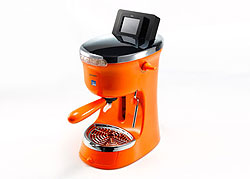LAS VEGAS — Jan. 9, 2009 — Few attendees at the 2009 International Consumer Electronics Show (CES) this week will be surprised to learn that the myriad gadgets of everyday life are getting smarter and more useful. But what may come as a surprise is that household appliances and devices are about to get connected to the outside world through cyberspace.

A Windows-enabled and Web-connected coffee maker like this prototype could check online for the proper grinding size of the beans you’ve just bought.
Among the technologies Microsoft is highlighting in its booth at CES this year is a hardware and software platform for the next generation of more useful and flexible household objects, appliances and accessories. The Windows-based platform is the result of a collaboration between Microsoft and a recently formed company called Fugoo. Two of the concept designs featured in a video at the booth are a “net” clock that, in addition to giving the time, can also download and display a stock ticker and local traffic and weather reports, and a digital photo frame that can not only download your latest holiday photos, but can also be programmed to display anything else available on the Internet, from current news headlines and sports scores to full-length movies.
“The combination of Fugoo’s platform and Microsoft Windows opens up almost limitless possibilities for transforming ordinary household items, allowing them to perform all sorts of new functions and services,” says Steve Guggenheimer, corporate vice president of the Original Equipment Manufacturer Division at Microsoft. “Imagine having your alarm clock not only wake you up but also remind you what your first appointment of the day is and calculate how long it will take you to drive to work based on current traffic conditions.”

Steve Guggenheimer, Corporate Vice President, Original Equipment Manufacturer Division.
Rethinking Common Objects
Fugoo was started a year ago by John Hui and Chris Chung, who previously co-founded eMachines, and by Wayne Inouye, a former chief executive officer of eMachines and Gateway. The name Fugoo is a variant of fugu, a delicacy among sashimi aficionados, and a nod to another Hui venture, FUHU Inc., which is developing the user interface for the Fugoo platform.
“Many vendors are trying to come up with a multipurpose magic bullet to satisfy all the information needs in the home,” says Hui. “But this sort of solution is bound to be expensive and complex. We’re taking a fundamentally different approach, building devices with computing power and Internet connections to perform specific functions in order to keep costs low and the user interface simple.”
Hui has coined the term “neo-diginet” to describe this new generation of Internet-linked devices. “Our platform will make it fast, easy and affordable to build an almost unlimited variety of neo-diginet devices — from digital photo frames to coffee makers and refrigerators— that will redefine the term ‘household appliance,’” he says.
Hui notes that because Internet connections are bidirectional, they can be used to upload as well as download data. For example, it might be possible to build a Fugoo-compatible computer mouse that doubles as a blood-pressure or blood-glucose monitor. Such a device would allow physicians to keep tabs on their hypertensive and diabetic patients between checkups by uploading data from the mouse.
Some Assembly Required
The popularity of the Windows operating system will make it easy for manufacturers and independent software vendors (ISVs) to create applications and programs for the Fugoo platform. “These applications will be offered in the form of software building blocks that consumers can mix and match to customize their specific device or appliance,” says Hui. To make it easy for consumers to customize the Fugoo devices, Fugoo has incorporated a consumer-friendly user interface into the platform. Using the interface, a consumer can decide what images or data will be downloaded and displayed on a photo frame, or how finely to grind the beans for her morning coffee.
Similarly, the Fugoo hardware platform is a “snap in” module that contains an x86-based processor from VIA Technologies and Wi-Fi connection capabilities. Foxconn, a world-leading electronics contract manufacturer, will be producing the devices.
Fugoo expects the first neo-diginet devices to hit the market in late 2009. Company leaders hope that once their technology proves its appeal, appliance and device manufacturers will start offering Fugoo-ready products equipped with docking ports for its modules, just as some cars now come equipped with docking stations for portable media players.
Says Hui, “One of the reasons we think the time is right for Web-enabled devices is that there’s been an explosion in the availability of Web widgets, which essentially automate the process of retrieving a particular category of information.”
If Hui and his team are successful, where might this lead in the future? How about a refrigerator that can generate a weekly shopping list based on staples that have been used up, and then place a delivery order at a local supermarket’s Web site? Or a lawn sprinkler that checks the weather forecast for the possibility of rain before turning itself on? Or a dishwasher that can link to its manufacturer when it is malfunctioning, so the manufacturer can run remote diagnostics?
And maybe — just maybe — once all these devices are connected, they will also start talking to one another, like your “net” clock telling the coffee maker that you’re awake so it knows to start brewing.




